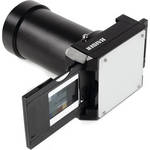Wayne Larmon wrote:
mdiphoto wrote:
I am using my Nikon D600 also to "scan" pictures from 35mm black and white film. For that I use a Kaiser film duplikator and an old Nikkor 35-80mm lens.
This one?
Kaiser Digital Slide Duplicator (with the Kaiser
film strip carrier )
I investigated it but discovered that the tube is non-adjustable such that it only works on zoom lenses. IMO, this is very sub-optimal, because zoom lenses aren't suited at all for copying flat objects. You need a lens with a flat focus plane. Which means a macro lens. Or maybe a lens from an enlarger.
Cool. They look good at web resolution but soft corners don't show up at web resolution.
I like the idea of camera scanning a lot. Camera scanning
can be as good as drum scanning. But implementing camera scanning is tricky because there aren't many off-the-shelf solutions. I'm using a Canon 60D (not as good as your D600), a Canon 60mm macro lens, and a
PhotoSolve Extend-a-Slide. The Extend-a-Slide
carrier for slides works well, but the
Extend-a-Slide film carrier isn't as good as the Kaiser film carrier (IMO). I use a modified version of the Extend-a-slide film carrier.
Unfortunately, the Kaiser duplicator has a fatal flaw (IMO) in that the tube isn't adjustable, which limits it to working with zoom lenses (I wrote Kaiser to confirm this.) In addition to the non-flat focus field issue, it is a bad idea to hang something heavy onto the end of a lens that isn't internal focus, because all the weight of the film carrier is bearing on the lens's internal mechanism. My Canon 60mm macro lens is internal focus--the exterior is a solid tube, so this isn't an issue.
I wish it was possible to use the Kaiser slide and negative carriers with the PhotoSolve adjustable tube, but apparently this isn't possible (according to Kaiser.) Camera scanning has a lot of potential (for those of us that don't have drum scanners), but thus far, requires a certain amount of custom fabrication.
Wayne















